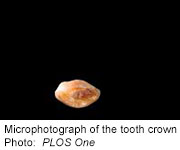
WEDNESDAY, Sept. 19 (HealthDay News) — A 6,500-year-old tooth with traces of beeswax filling may provide evidence of early human dentistry, researchers say.
The tooth was found in a human jawbone discovered near Trieste, Slovenia, according to a report in the Sept. 19 issue of the journal PLoS One.
Evidence of ancient dentistry is rare, so this tooth may help provide insight into early dental practices.
“This finding is perhaps the most ancient evidence of prehistoric dentistry in Europe and the earliest known direct example of therapeutic-palliative dental filling so far,” study co-leader Federico Bernardini, of the Abdus Salam International Center for Theoretical Physics, in Italy, said in a journal news release.
The beeswax in the tooth was applied around the time of the person’s death, but the researchers can’t confirm whether it was shortly before or after death. If it was applied before death, it was likely intended to reduce pain and sensitivity from a vertical crack in the enamel and dentin layers of the tooth, the researchers suggest.
The tooth has severe wear likely caused by non-eating activities, such as weaving, which was generally performed by females during the Neolithic age.
More information
The National Museum of Dentistry highlights moments in dental history.

